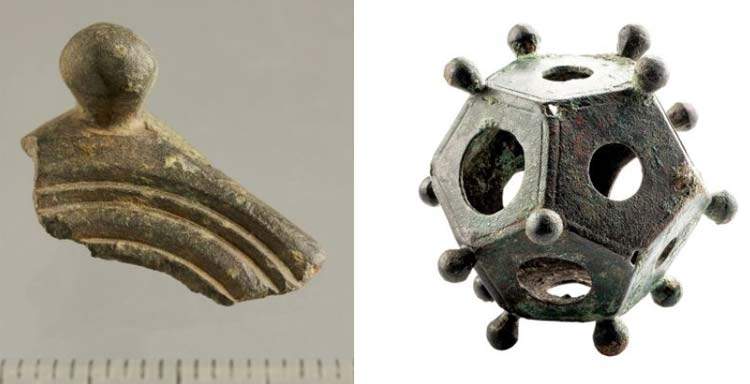Flanders, rare fragment of a mysterious Roman dodecahedron found
In Flanders (Belgium), specifically in the municipality of Kortessem (province of Limburg), a metal detector enthusiast, Patrick Schuermans, found a rare fragment of a Roman dodecahedron. The find was immediately reported to the Flanders Heritage Agency, which has now thoroughly investigated the discovery. This is an important discovery for Flanders, because so far only one Roman dodecahedron had been found in the entire Flemish territory (about a hundred are known, while there are only two in Belgium: one is in the Gallo-Roman Museum in Tongeren, found in 1939, and the other, discovered instead in the late 19th century, is in the Grand Curtius Museum in Liège). Schuermans has already stated that he will donate the dodecahedron fragment to the same Gallo-Roman Museum in Tongeren in the hope that it will be displayed.
Dating back to the Roman period, dodecahedrons are mysterious bronze geometric figures made using the lost-wax technique. They consist of twelve pentagonal faces with circular openings of different sizes, with usually some small spheres on the angels. However, it is still not known what they were used for: archaeologists and historians have not been able to provide an answer that convinces everyone. Over the years many hypotheses have been made about the function of these foreign objects (sling ball gauge, pipe joint, objects related to religious rituals, measuring systems), but there is no conclusive explanation. The fact that the known specimens are too different in size and detail tends to rule out the possibility that they may be measuring objects. According to archaeologists from the Flanders Heritage Agency, their significance should probably be sought in the magical-religious sphere. This could explain why a significant number of dodecahedrons are related to funerary finds.
It is also relevant that dodecahedrons have not been found in the area around or south of the Mediterranean Sea. Most of the known specimens were found in the northwestern part of the Roman Empire, including present-day Belgium, the Netherlands, Germany, France, and Great Britain. An area that coincides with that of the Celtic civilization. That is why they are also sometimes called Gallo-Roman dodecahedrons. Known complete specimens differ in detail in appearance and also vary in size and weight. Most range in size from 4.5 to 8.5 centimeters.
The fragment recently discovered in Limburg was part of a dodecahedron measuring 5 to 6 centimeters. Researchers from the Flanders Heritage Agency found evidence of a repair on the piece. Based on the fracture surfaces, they suspect that this dodecahedron may have been broken during a ritual as early as the Roman period. However, the really interesting fact is that for the first time in Flanders the exact location of a dodecahedron is known, and this according to experts opens the door for further research.
Photo left: the fragment found (© Onroerend Erfgoed, photo: Kris Vandevorst). Photo right: the Roman dodecahedron in the Gallo-Roman Museum in Tongeren (© Gallo-Roman Museum)
 |
| Flanders, rare fragment of a mysterious Roman dodecahedron found |
Warning: the translation into English of the original Italian article was created using automatic tools. We undertake to review all articles, but we do not guarantee the total absence of inaccuracies in the translation due to the program. You can find the original by clicking on the ITA button. If you find any mistake,please contact us.




























